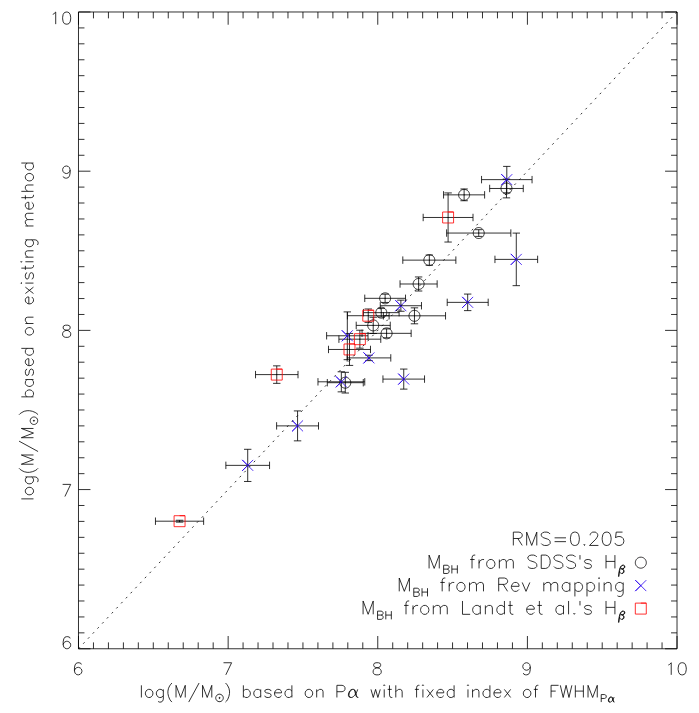Infrared Bolometric Luminosity & Black Hole Mass Estimators (Click)
Supermassive black holes (SMBHs) at centers of spheroid galaxies radiate enormous energy during their active phase, and these powerful black hole (BH) activities are considred to play an important role in the galaxy evolution by regulating the star formation activity in their host galaxies. Therefore, it is very important to measure the black hole masses and their activities to understand the galaxy evolution.
Usually, C IV, Mg II, Hβ, Hα lines were used for estimating BH masses. These UV and optical BH mass estimators are enough for normal, type-1 active galactic nuclei (AGNs). However, dusty red AGNs are believed to occupy 15~50% of the AGN population, and the UV and optical BH mass estimators are easily obscured by dust extinction. Hence, I derived two infra-red (IR) BH mass estimators by using hydrogen Paschen and Brackett lines for dust red AGNs, which are presented in below.

I derived new BH mass estimators based on velocity widths and luminosities of near-infrared (NIR) hydrogen Paschen lines (Pβ: 1.28 and Pα: 1.87 μm). To derive the BH mass estimators, I used a sample of 37 unobscured type 1 AGNs, where BH mass comes from either the reverberation mapping method or single-epoch measurement method using Balmer lines. This result shows that BH mass can be estimated from the Paschen line luminosities and velocity widths to an accuracy of 0.18–0.24 dex (rms scatter). I expect future application of these new BH mass estimators on dusty red AGNs to provide a comprehensive view of AGNs.

I obtained 2.5-5.0 μm spectra of 83 nearby (0.002 < z < 0.48) and bright (K < 14 mag) type-1 AGNs taken with the Infrared Camera on board AKARI. The 2.5-5.0 μm spectral region contains emission lines such as Brβ (2.63 μm), Brα (4.05 μm), and polycyclic aromatic hydrocarbons (3.3 μm), which can be used for studying the BH masses and star formation activities in the AGN host galaxies. The observed type-1 AGNs are selected from bright quasar surveys of Palomar-Green and SNUQSO, and AGNs with reverberation-mapped BH masses from Peterson et al. Using 11 AGNs with reliable detection of Brackett lines, I derived the Brackett-line-based BH mass estimators.